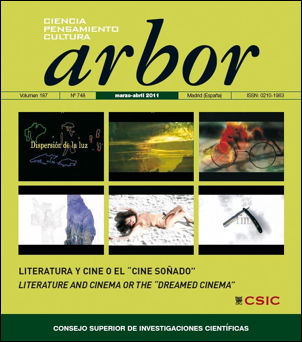The Beauty and the Beast in Guillermo del Toro’s labyrinthine trip: El espinazo del diablo (2001) y El Laberinto del Fauno (2006)
DOI:
https://doi.org/10.3989/arbor.2011.748n2017Keywords:
Guillermo del Toro, The Devil’s Backbone, Pan’s Labyrinth, cinema, monstrosity, genderAbstract
The films The Devil’s Backbone (2001) and Pan’s Labyrinth (2006) are both directed by Mexican Guillermo del Toro, and they are considered his Spanish films. Both films are set during the Spanish Civil War, but none of them explicitly deals with this tragic historical episode. However, this tense and oppressive context enables Del Toro to explore a theme of a greater complexity: Monstrosity and its relationship to the cultural notion of gender. Monsters are traditionally the epitome of fear and the protagonists of fantasy genres. This study attempts to demonstrate, within the framework of psychoanalysis, that the Mexican filmmaker resorts to the juxtaposition of real and fantasy worlds in order to establish an eloquent parallelism between the representation of monstrosity and gender. Ultimately, Del Toro’s objective is to question and re-evaluate the symbolic and dominant patriarchal structures and its perverse consequences over the individual.
Downloads
References
Brashow, Peter (2006): “Reviews: Pans Labyrinth”, Guardian Unlimited Film, 24 noviembre, [acceso 14/6/2008].
Cohen, Jeffrey Jerome (1996): “Monster Culture (Seven Theses)”, en Jeffrey Jerome Cohen (ed.): Monster Theory: Reading Culture, London, Minneapolis, University of Minnesota Press.
Creed, Barbara (1993): Kristeva, Feminity, Abjection, en Barbara Creed, The Monstruous Feminine: Film, Feminism, Psychoanalysis, London: Routledge.
French, Philip (2001): “Reviews: The Devil’s Backbone”, Guardian Unlimited Film, 2 diciembre [acceso 20/06/2008].
Gelder, Ken (ed.) (2000): The Horror Reader, London, Routledge.
Grossvogel, David I. (1972): “Buñuel’s Obsessed Camera: Tristana dismembered”, Diacritics, 3, pp. 46-56. doi:10.2307/464527
Halberstam, Judith (1995): Skin Shows: Gothic Horror and the Technology of Monsters, Durham, N.C., Duke University Press.
Homer, Sean (2005): Jaques Lacan, London, Routledge. doi:10.4324/9780203347232
Irigaray, Luce (1993): “Why Defined Sexed Rights?”, en Je, Tu, Nous. Trad. por Alison Martin, New York, Routledge.
Jump, John D. (ed.) (1972): The Grotesque, London, Methuen & Co.
Kaplan, E. Ann (2000): “Is the Male Gaze?”, en E. Ann Kaplan (ed.), Feminism and Film, Oxford, Oxford University Press.
Mulvey, Laura (1988): “Visual Pleasure and Narrative Cinema”, en Constance Penley (ed.), Feminism and Film Theory, New York; London, Routledge, pp. 57-68.
Mulvey, Laura (2000): “Visual Pleasure and Narrative Cinema”, en E. Ann Kaplan (ed.), Feminism and Film, Oxford, Oxford University Press.
Rowe, Katheleen (1995): The Unruly Woman: Gender and the Genres of Laughter, Dallas, University of Texas Press.
Thornman, Susan (2000): Passionate Detachments. An Introduction to Feminist Theory, Edinburgh, Edinburgh University Press.
Whitford, Margaret (1991): Luce Irigaray. Philosophy in the Feminine, London; New York, Routledge.
Wood, Jason (2007): “Excerpts taken from The Father Book of Mexican Cinema and Talking Movies, Contemporary World Filmmakers in Interview”, en Guillermo del Toro Collection - Pan’s Laberynth, Cronos, The Devil’s Backbone DVD (Optimum Home Entertainment).
Downloads
Published
How to Cite
Issue
Section
License
Copyright (c) 2011 Consejo Superior de Investigaciones Científicas (CSIC)

This work is licensed under a Creative Commons Attribution 4.0 International License.
© CSIC. Manuscripts published in both the printed and online versions of this Journal are the property of Consejo Superior de Investigaciones Científicas, and quoting this source is a requirement for any partial or full reproduction.
All contents of this electronic edition, except where otherwise noted, are distributed under a “Creative Commons Attribution 4.0 International” (CC BY 4.0) License. You may read the basic information and the legal text of the license. The indication of the CC BY 4.0 License must be expressly stated in this way when necessary.
Self-archiving in repositories, personal webpages or similar, of any version other than the published by the Editor, is not allowed.














